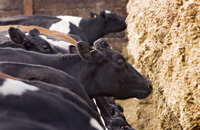Mixed first-cut silage as May rain hinders quality

With rain in late May hindering first-cut silage quality for many, knowing what is in the clamp and planning rations will be essential to optimise cow performance, according to Frank Wright Trouw Nutrition International technical director John Allen. However, quality is similar to last year, he adds.
“In the past two winters, many herds have been about two litres for every cow a day below target yields and there are early indications that it could be similar this year,” Mr Allen says.
Results from more than 600 first-cut grass silage samples analysed by the company show dry matter content is slightly better than last year at 31.5%, although energy and protein contents are similar to 2008 at 10.8MJ/kgDM and 13.6% CP respectively.
Similar results have been seen in the south-west, with Douglas Green of Green and Kelly Dairy Consultants splitting silage quality into two camps. “It has been a great season so far, but rain in late May frustrated silage making for many producers. Those cutting early have excellent quality silage with MEs at 11 MJ/kgDM. But those cutting from about 24 May onwards have similar results to last year, with some dry, over stemmy silage and energy about 10.5MJ/kgDM.
“Farmers cutting later will have to focus carefully when formulating the ration, with whole crop a good and easy way to balance the diet,” he says.
In Cheshire, apart from the rain catching some out, Phil Clarke of P and L Agriconsulting , says this year has been the best forage growing season he has seen in the county. “There is no shortage of grass silage in Cheshire this year, but two different situations have occurred. Those cutting early May have seen energy up at 11.5MK/kg/DM and crude protein about 15%, but with less yields. However, those cutting later have seen great yields with some clamps full from first cut only, with MEs about 10.3MJ/kgDM and crude protein 12.5%,” he says.
A small variation in energy can make a big difference to what needs to be fed, says Mr Clarke. “A difference of one ME point is worth an extra 1kg of cake, which over a year equates to a considerable amount of money.”
However, north of the border, the growing season has not been so rosy, with cold, dry weather limiting growth, says SAC senior dairy consultant Jimmie Goldie. “Yields and quality has been varied and planning for winter will be essential. For some farmers waiting to take second cut, housing cows at night can help alleviate more grass for silage,” he says.
With average results being seen through the country, Dr Allen predicts average silage will lack the rumen energy necessary to maximise rumen digestion and promote milk production. “Since 60-70% of the energy needed by the cow for maintenance and milk production originates from rumen microbial fermentation, it is critical to maximise and balance the rumen nutrient supply.”
He advises providing starchy feeds to boost rumen energy to balance average grass silage, particularly the supply of rumen nitrogen, as removing excess nitrogen requires energy. “Excreting 500g of excess nitrogen requires the same energy as it takes to produce one litre of milk, further depressing yields.”
